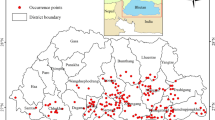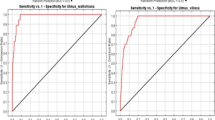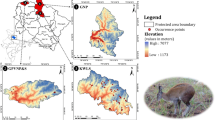Abstract
Ecological factors that control the species distribution patterns at various spatiotemporal scales will get affected by climate change. To combat the situation, in the past few decades geographical information system (GIS) and remote sensing have been widely used by the researchers in the field of wildlife and habitat suitability modeling. The main objective of this study is to map and predict the current and future habitat suitability potential of Rucervus eldii eldii in Keibul Lamjao National Park (KLNP) using MaxEnt. Presence location data of the species, topographic factors, and bio-climatic variables were used as input in the MaxEnt software to map current habitat suitability potential. To map the habitat suitability potential for future, two representative concentration pathway (RCP) scenarios RCP 2.6 and RCP 8.5 for the years 2050 and 2070 were used. The model returned an average AUC value of 0.944 which indicates the model to be sensitive and descriptive. Isothermality and precipitation in the wettest quarter were found to be two most significant variables. The suitable range of precipitation in the wettest quarter for Rucervus eldii eldii varies from 1365 to 1410 mm with an optimal value of 1405 mm and isothermality from 46.43 to 46.6% with an optimal value of 46.5%. Current habitat suitability results of the model show 0.45 km2 of the area under no potential, 29.25 km2 of the area under least potential, 8.29 km2 of the area under moderate potential, 9.21 km2 of the area under good potential, and 8.82 km2 of the area under high potential. Both RCPs for the years 2050 and 2070 show the decreasing trend in the area under high suitability potential and increasing trend under no suitability potential. The results of this study can provide aid in the management and protection of Rucervus eldii eldii.









Similar content being viewed by others
Data availability
The datasets used during the current study are available from the corresponding author on reasonable request.
References
Adhikari, D., Barik, S., & Upadhaya, K. (2012). Habitat distribution modelling for reintroduction of Ilex khasiana Purk., a critically endangered tree species of northeastern India. Ecological Engineering, 40, 37–43.
Anand, V., & Oinam, B (2020). Future land use land cover prediction with special emphasis on urbanization and wetlands. Remote Sensing Letters, 11(3), 225–234.
Barnosky, A. D., Matzke, N., Tomiya, S., Wogan, G. O., Swartz, B., Quental, T. B., Marshall, C., McGuire J. L., Lindsey, E. L., & Maguire, K. C. (2011). Has the Earth’s sixth mass extinction already arrived? Nature, 471, 51–57.
Bertrand, R., Lenoir, J., Piedallu. C., Riofrío-Dillon, G., de Ruray, P., Vidal, C., Pierrat, J. C., & Gégout, J. N. (2011). Changes in plant community composition lag behind climate warming in lowland forests. Nature, 479, 517–520.
Cauwer, V. D., Muys, B., Revermann, R., & Trabucco, A. (2014). Potential, realised, future distribution and environmental suitability for Pterocarpus angolensis DC in southern Africa. Forest Ecology and Management, 315, 211–226.
Çoban, H. O., Omer, K., Orucu, E., & Arslan, S. (2020). MaxEnt modeling for predicting the current and future potential geographical distribution of Quercus libani Olivier. Sustainability, 12, 2671. https://doi.org/10.3390/su12072671
Coban, H. O., Koc, A., & Eker, M. (2010). Investigation on changes in complex vegetation coverage using multi-temporal landsat data of Western Black sea region—A case study. Journal of Environmental Biology, 31, 169–178.
Eastmann, R. (2016). TerrSet Habitat and Biodiversity Modeller Manual. Clark Labs.
Elith, J., Graham, C. H., Anderson, R. P., Dudik, M., Ferrier, S., Guisan, A., Hijmans, R. J., Huettmann, F., Leathwick, J. R., Lehmann, A., Li, J., Lohmann, L. G., Loiselle, B. A., Manion, G., Moritz, C., Nakamura, M., Nakazawa, Y., Overton, J. M., Peterson, A. T., Phillips, S. J., Richardson, K., Scachetti-Pereira, R., Schapire, R. E., Soberón, J., Williams, S., Wisz, M. S., & Zimmermann, N. E. (2006). Novel methods improve prediction of species’ distributions from occurrence data. Ecography, 29(2), 129–151.
Etherington T. (2019). Mahalanobis distances and ecological niche modelling: Correcting a chi-squared probability. PeerJ, 7, e6678. https://doi.org/10.7717/peerj.6678
Fick, S. E., & Hijmans, R. J. (2017). WorldClim 2: New 1-km spatial resolution climate surfaces for global land areas. International Journal of Climatology, 37(12), 4302–4315.
Forest Department Government of Manipur. (2013). Conservation of Sangai: A Success Story. Department of Forest, Government of Manipur.
Fourcade, Y., Besnard, A. G., & Secondi, J. (2017). Paintings predict the distribution of species, or the challenge of selecting environmental predictors and evaluation statistics. Global Ecology and Biogeography, 27(1–2), 245–256.
Fourcade, Y., Engler, J. O., Rödder, D., & Secondi, J. (2014). Mapping species distributions with MaxEnt using a geographically biased sample of presence data: a performance assessment of methods for correcting sampling bias. PLoS One, 9(5), e97122. https://doi.org/10.1371/journal.pone.0097122
Gaston, K. J. (1996). Species Richness: Measure and Measurement. Biodiversity: A Biology of Numbers and Difference; Blackwell Science: Hoboken, NJ, USA, pp. 77–113.
Gee, E. P. (1960). Report on the status of brow-antlered deer of Manipur (India). Journal of The Bombay Natural History Society, 57, 597–617.
Ghosh, S. (2018). A report: Seeking a second home for Manipur’s dancing deer.
Hijmans, R. J., Cameron, S. E., Parra, J. L., Jones, P. G., & Jarvis, A. (2005). Very high resolution interpolated climate surfaces for global land areas. International Journal of Climatology, 25, 1965–1978.
Hill, M. P., Hoffmann, A. A., McColl, S. A., & Umina, P. A. (2012). Distribution of cryptic blue oat mite species in Australia: Current and future climate conditions. Agricultural and Forest Entomology, 14, 127–137.
IPCC. (2014). Climate Change 2014: Synthesis Report. Contribution of Working Groups I, II and III to the Fifth Assessment Report of the Intergovernmental Panel on Climate Change; IPCC: Geneva, Switzerland, p. 151.
Jayakumar, S., Remya, K., & Ramachandran, A. (2015). Predicting the current and future suitable habitat distribution of Myristica dactyloides Gaertn. using MaxEnt model in the Eastern Ghats India. Ecological Engineering, 82, 184–188. https://doi.org/10.1016/j.ecoleng.2015.04.053
Kushwaha, S. (2012). Modelling of habitat suitability for Gaur (Bos gaurus) using multiple logistic regression, remote sensing and GIS. Journal of Applied Animal Research.
Liu, Y., Huang, P., Lin, F., Yang, W., Gaisberger, H., Christopher, K., & Zheng, Y. (2019). MaxEnt modelling for predicting the potential distribution of a near threatened rosewood species (Dalbergia cultrata Graham ex Benth). Ecological Engineering, 141, 105612.
Loktak Development Authority (LDA). (2003). Extension Proposal. Sustainable Development and Water Resource Management of Loktak Lake. Imphal, Manipur, India. Loktak Development Authority and Wetlands International South Asia.
Morales, N. S., Fernández, I. C., & Baca-González, V. (2017). MaxEnt’s parameter configuration and small samples: Are we paying attention to recommendations? A systematic review. PeerJ, 5, e3093. https://doi.org/10.7717/peerj.3093
Pearson, R. G., Raxworthy, C. J., Nakamura, M., & Peterson, A. T. (2007). Predicting species distributions from small numbers of occurrence records: A test case using cryptic geckos in Madagascar. Journal of Biogeography, 34, 102–117.
Phillips, S. J., Anderson, R., DudÍk, M., Schapire, R., & Blair, M. (2017). Opening the black box: An open-source release of Maxent. Ecography. https://doi.org/10.1111/ecog.03049
Phillips, S. J., Anderson, R. P., & Schapire, R. E. (2006). Maximum entropy modeling of species geographic distributions. Ecological Modelling, 190, 3–4 231–259.
Phillips, S. J., & Dudik, M. (2008). Modeling of species distributions with Maxent: New extensions and a comprehensive evaluation. Ecography, 31, 161–175.
Proosdij, A. J., Sosef, M., Wieringa, J., & Raes, N. (2016). Minimum required number of specimen records to develop accurate species distribution models. Ecography, 39, 542–552. https://doi.org/10.1111/ecog.01509
Ranjitsinh, M. K. (1975). Keibul Lamjao Sanctuary and the brow-antlered deer – 1972, with notes on a visit in 1975. Journal of The Bombay Natural History Society, 72, 214–255.
Sangermano, F., & Eastman, R. (2007). Linking GIS and ecology - the use of Mahalanobis typicalities to model species distribution. XI Conferencia Iberoamericana de Sistemas deInforma- coin Geográfica, BuenosAires.
Shamungou, K. H. (2010). Endangered Manipur Brow Antlered Deer (An Environmental Assessment), Department of Forest (Wildlife Wing), Government of Manipur, Published by: The Department of Forest Sanjengthong, Imphal Government of Manipur.
Shamungou, K. H. (1990). Habitat devastation threatens Manipur brow-antlered deer (Cervus eldii eldii McClelland, 1842). Deer, 8(2), 99–101.
Store, R., & Jokimäki, J. (2003). A GIS-based multi-scale approach to habitat suitability modeling. Ecological Modelling, 169, 1–15.
Türkeş¸ M. (2008). Küresel iklim değişikliği nedir? Temel kavramlar, nedenleri, gözlenen ve öngörülen değişiklikler. İklim Değişikliği ve Çevre, 1, 26–37.
Wang, R. L., Li, Q., Feng, C. H., & Shi, Z. P. (2017). Predicting potential ecological distribution of Locusta migratoria tibetensis in China using MaxEnt ecological niche modeling. Acta Ecologica Sinica, 37(24), 8556–8566.
Wang, Y. S., Xie, B. Y., Wan, F. H., Xiao, Q. M., & Dai, L. Y. (2007). The potential geographic distribution of Radopholus similis in China. Agricultural Sciences in China, 6, 1444–1449.
Watts, M., & Worner, S. (2010). Modelling Insect Habitat Suitability with Artificial Neural Networks. Insect Habitats: Characteristics, Diversity and Management.
Worth, J. R., Harrison, P. A., Williamson, G. J., & Jordan, G. J. (2015). Whole range and regional-based ecological niche models predicting exposure to 21st century climate change in the key cool temperate rainforest tree southern beech (Nothofagus cunninghamii). Austral Ecology, 40, 126–138.
Yi, Y. J., Cheng, X., Yang, Z. F., & Zhang, S. H. (2016). MaxEnt modeling for predicting the potential distribution of endangered medicinal plant (H. riparia, Lour) in Yunnan China. Ecological Engineering, 92, 260–269.
Acknowledgements
The authors express their heartfelt gratitude to the National Remote Sensing Centre (NRSC), WorldClim and Forest Department, Government of Manipur, for providing the valuable database.
Funding
The research outcome of this study was funded in form of project under the third phase of Technical Education Quality Improvement Programme (TEQIP-III), National Institute of Technology, Manipur (NIT-M).
Author information
Authors and Affiliations
Contributions
BO and VA conceived the idea and designed the experiment. IHS collected and compiled the field data. Writing and editing was done by VA. Both VA and BO analyzed the result. All the authors read and approved the manuscript.
Corresponding author
Ethics declarations
Conflict of interest
The authors declare that they have no conflict of interest.
Additional information
Publisher’s Note
Springer Nature remains neutral with regard to jurisdictional claims in published maps and institutional affiliations.
Rights and permissions
About this article
Cite this article
Anand, V., Oinam, B. & Singh, I.H. Predicting the current and future potential spatial distribution of endangered Rucervus eldii eldii (Sangai) using MaxEnt model. Environ Monit Assess 193, 147 (2021). https://doi.org/10.1007/s10661-021-08950-1
Received:
Accepted:
Published:
DOI: https://doi.org/10.1007/s10661-021-08950-1




